9 September 2023 – Fabiënne Tetteroo
Months ago I was planning to publish a short article on the Franklin Expedition portraits in The Illustrated London News on 13 September, the anniversary of their publication in 1851. Never in my wildest dreams could I have imagined that by that time a ‘lost’ set of the daguerreotypes would have suddenly appeared! On 24 August 2023 Sotheby’s London published the catalogue of their September auction Travel, Atlases, Maps, Photographs & Natural History, including the set of Daguerreotype portraits [see image above] taken of the officers of HMS Erebus plus Captain Francis Crozier as the only representative of HMS Terror. From photographic reproductions showing some of the officers in different poses than in the Franklin Expedition daguerreotypes at the Scott Polar Research Institute in Cambridge (SPRI), it had always been known that there must have been another set made. The set at SPRI was allegedly the one owned by Lady Jane Franklin (1791-1875), after whose death Sir John Franklin’s niece and Jane’s companion Sophia Cracroft (1816-1891) inherited them. Through her relations the Lefroy family (Sophia Cracroft’s sister Emma married George Benjamin Austen Lefroy, a grandson of writer Jane Austen’s brother James) the set was ultimately donated to SPRI in 1941. The provenance of the SPRI and Sotheby’s sets seemed clear, but the more I thought about it the less clear it became…
At the time of writing this the auction at Sotheby’s has not yet closed. It is my hope and that of many others that these daguerreotypes that have such a huge historical and emotional significance end up at a public institution instead of disappearing again into a private collection. Now that Franklin’s family is selling them, the time has come for them to serve as a public memorial to the unfortunate souls of the Franklin Expedition.
Sets of Daguerreotypes
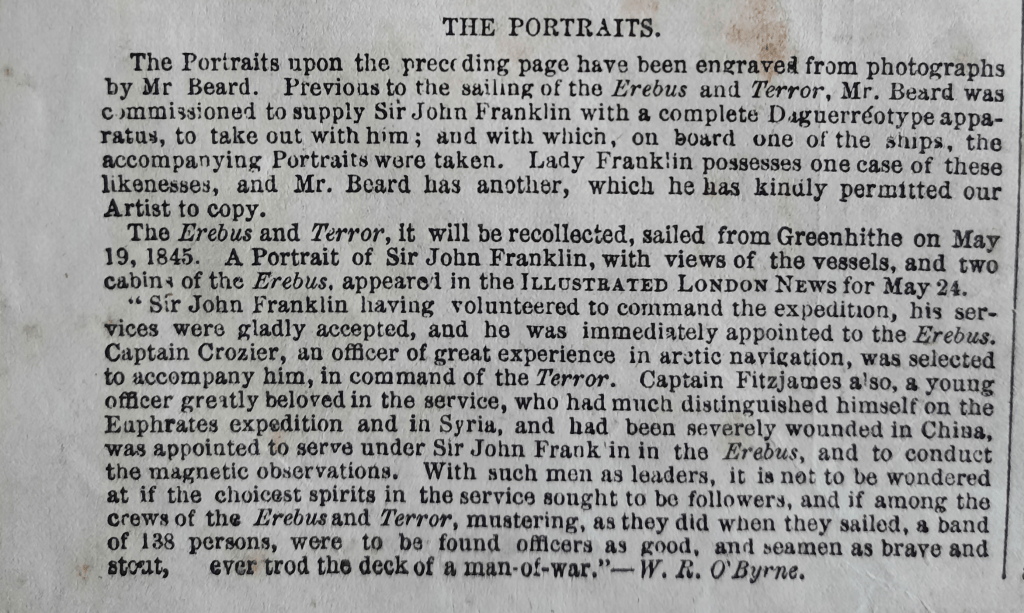
From the article accompanying the ILN portraits [see left] we learn that: “Lady Franklin possesses one case of these likenesses, and Mr. Beard has another, which he has kindly permitted our Artist to copy.”
When news of the Sotheby’s set broke I immediately assumed that this must be Beard’s long lost set, thinking that SPRI had Lady Franklin’s set. However the Sotheby’s set belonged to a direct descendant of Sir John Franklin, according to the auction house. Franklin only had one child by his first wife Eleanor Porden (1795-1825), a daughter called Eleanor (1823-1860) after her mother. She married John Philip Gell (1816-1898) and they had seven children, naming their first child John Franklin Gell (1851-1884). The person who owned the Sotheby’s set can only be a descendant of one of those children, as Sir John never had any more children with Jane. Eleanor Gell and Lady Franklin were not on good terms after a dispute about Sir John’s estate [McCorristine, Shane. “A Manuscript History of the Franklin Family by Sophia Cracroft (1853).” Polar Record 51, no. 1, 2015, p. 74], but after Eleanor’s death Lady Franklin was at least in touch with Sir John’s grandchildren who called her Grandmamma [see this 1873 letter].
Notice however how the article says that Lady Franklin and Beard both own a “case” of the portraits. The set at SPRI does not come in a case, the daguerreotypes are all in individual cases plus the portraits of Crozier and Robert Orme Sargent are missing. It is possible that the original case was dismantled for some reason. When putting the Sotheby’s and SPRI daguerreotypes side by side, we see that with some (Franklin, Osmer, Stanley, Goodsir, and Le Vesconte) the daguerreotypes are mirror images of each other. There being no differences between the two, the only logical conclusion can be that SPRI has daguerreotypes that were made of the original daguerreotypes. This was the only way to make copies since a daguerreotype is unique. The SPRI ‘set’ actually does not seem like a set at all, but rather a combination of originals and ‘copies’. (Watch these very instructive videos by the Victoria & Albert Museum and the Getty Museum about the daguerreotype process, and see this manual by The Daguerreian Society.)

Sotheby’s states that the set now for sale was used for the ILN illustrations, and the evidence they provide for this claim is the observation that the illustrations are exact mirror images of their set. Indeed a wood engraving can produce a mirror image when printed, if the drawing is not reversed on the block of wood. If however the illustration was first drawn on paper and then transferred onto the wood block, the artist could flip over the paper with the drawing so that when printed the original orientation was maintained (something you can also see this modern day artist do).
The engraver who made the Franklin Expedition portraits is Frederick James Smyth, whose signature “Smyth” is visible in the lower right corner of Henry Collins’ portrait. [see left] Smyth produced many works for the ILN, such as a panorama of London in 1845. This panorama could not be printed in reverse or else it would not be correct. When comparing the other portraits engraved by Smyth that were based on existing portraits, we can see that he maintained the orientation of the image he was copying:


Right: Sir William Fenwick Williams and Sir Christopher Charles Teesdale (1883 copy after 1854-6 original) [Royal Collection Trust / © His Majesty King Charles III 2023]
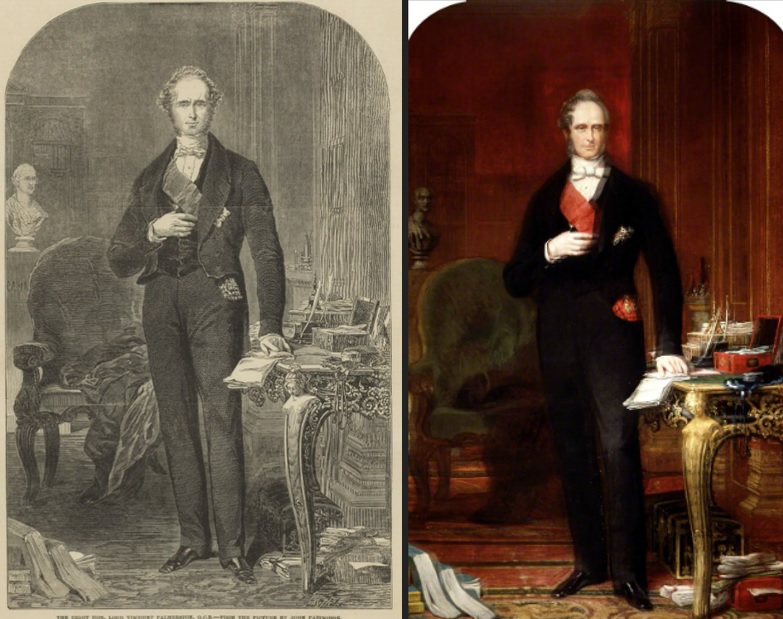
Right: Henry 3rd Viscount Palmerston (1784–1865), Prime Minister by John Partridge, oil on canvas, 1850. © Parliamentary Art Collection WOA 5196
Now we have seen that a wood engraving does not automatically mean that the printed image will be reversed, and that Smyth did not reverse the portraits I have just shown. This leads to the conclusion that Richard Beard owned a set of daguerreotype copies of Lady Franklin’s original set, and that Smyth faithfully copied what he saw, flipping the drawing on the woodblock so that the orientation would be unchanged. If this is the case, then the Sotheby’s set did not belong to Richard Beard. The logical owner seems to be Lady Franklin. Beard got a set of daguerreotypes of Lady Franklin’s set of daguerreotypes and these were used to make the ILN engravings. The set at SPRI is a mix of ‘copies’ and originals, ultimately owned by the Lefroy family. Could dags from Beard’s set be among those at SPRI, meaning Beard’s set does not exist as a set anymore? If the SPRI set is not Lady Franklin’s, and the Sotheby’s set belonged to a descendant of Eleanor Gell, then Lady Franklin’s set must have been given to the Gell family rather than to Sophia Cracroft.
Fitzjames’ second Daguerreotype
The reason Richard Beard had a set at all was presumably so that he could provide the family and friends of the officers portrayed with copies. Indeed as Harry Goodsir instructs his sister Jane:
You may get all or any of the likenesses to purchase at the following address
– Harry Goodsir to Jane Ross Goodsir [sister] on 19 May 1845
in London Mr. Beard 85, King William Street, City.
[Source: Russell Potter et al., May We Be Spared To Meet On Earth, 2022, p. 125]
SPRI has second portraits of both Fitzjames and Charles Frederick Des Voeux, that show them looking slightly more casual than their more formal looking counterparts in Sotheby’s set. Both Fitzjames and Des Voeux have taken on a different pose and show a slight smile. These second, more casual daguerreotypes would be just the kind to send to family and friends.

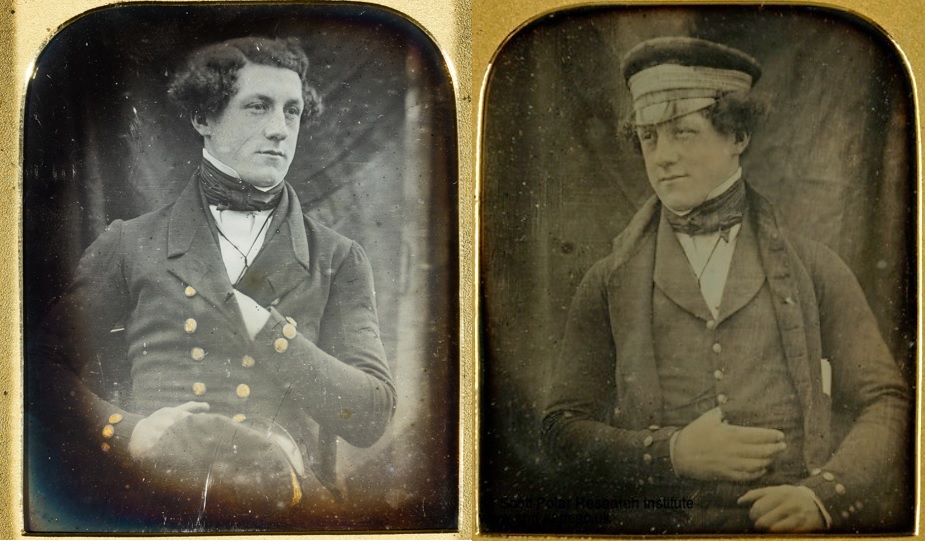
I have got a second [daguerreotype] for Elizabeth [Coningham] to whom
– James Fitzjames to William Coningham 16 May 1845
I shall send it when set. I believe it is very like me
Though I fear Lady Franklin will have the best – He [the photographer] comes on board tomorrow,
& I shall try & get 2 more. One for Fitzgerald [Gambier] & one for Mrs Campbell –
You will have the best of the three –
[Source: letter in private collection, on microfilm at Caird Library MRF/89, also in: May We Be Spared…, 2022, p. 117]
Fitzjames told William that he had gotten a second daguerreotype for Elizabeth (and William), and was planning to ask the photographer for “2 more” to send to his half-brother Fitzgerald Gambier and his friend Anne Maria Campbell. Confusingly Fitzjames says that Elizabeth & William will get the best of the three. The two Fitzjames daguerreotypes that we know of each show him in a different pose: one where he is holding a telescope, the other without telescope and with his hand on his hip. If the one with the telescope is considered to be the first and also the ‘official’ one with him holding a naval attribute, the one without the telescope would be the second daguerreotype that Fitzjames got for the Coninghams. However, William Coningham’s descendants do not seem to have such a daguerreotype, and I will have to consult auction catalogues to see if a Fitzjames daguerreotype was sold at some point just like most of Fitzjames’ medals that had been given to William and Elizabeth.
Another question is: how did Sir Clements Markham (1830-1916) obtain a very high quality picture [see below] of this daguerreotype to put into his unpublished Franklin Expedition novel James Fitzjames: the story of friendships, devoted zeal for service etc. of 129 British naval officers and seamen written between 1899 and 1913? He also included pictures of the other SPRI dags of Franklin, Gore, Le Vesconte, Fairholme, Des Voeux, Couch, Stanley, Goodsir, Osmer, Reid and Collins. That is the full set that was donated to SPRI in 1941, and Markham must have been in touch with the owner of the set. More information might be found in his letters and journals at the Royal Geographical Society. What is interesting to know is that apparently by 1899-1913, the set now at SPRI was already incomplete. Unless Markham was simply not interested in including Crozier and Sargent, it would be quite a coincidence if he happened to skip those two that are missing now.

I hope Elizabeth [his sister] got my photograph. Lady Franklin said she thought
– James Walter Fairholme to George Fairholme [father] on 29 May 1845
it made me look too old, but as I had Fitzjames’ coat on at the time,
to save myself the trouble of getting my own, you will perceive that I
am a Commander, & have anchors on the epaulettes so it will do
capitally when that is really the case.
[Source: Russell Potter et al., May We Be Spared To Meet On Earth, 2022, p. 146]
Thus far a calotype copy of a third daguerreotype of Lieutenant James Walter Fairholme (now in the Canadian Museum of History) and a copy of Lieutenant Henry Thomas Dundas Le Vesconte’s daguerreotype (still owned by descendants) have surfaced. Fairholme’s third daguerreotype was incorperated into a display of silhouette portraits of his family. This set was sold at auction by Bonhams in 2003. For Fairholme we have two Daguerreotypes with an identical pose (Sotheby’s and SPRI) of him with his arms crossed and a rather serious look. The third one (Bonhams) comes across as more casual and is indeed the one that ended up with his family. With fourteen officers having had their portrait taken, theoretically there must be more copies or original daguerreotypes still out there somewhere…
Conclusions
To sum it all up:
SPRI
– Daguerreotypes donated to SPRI in 1941 by Miss Jessie Lefroy, a descendant of Sophia Cracroft’s sister Emma.
– The daguerreotypes come in individual cases as opposed to the full case set that the ILN says Lady Franklin and Richard Beard both had.
– SPRI has daguerreotypes of Fitzjames and Des Voeux in different poses than the Sotheby’s set.
– Crozier and Sargent are missing.
– The portraits of Franklin, Osmer, Stanley, Goodsir, and Le Vesconte are mirror images of the ones in the Sotheby’s set.
– Seems to be a mix of copies and originals. Remnants of Richard Beard’s set?
– Clements Markham included pictures of this set in his unpublished 1899-1913 Franklin Expedition novel. Crozier and Sargent’s portraits were already missing from the set.
Sotheby’s
– The portraits are all together in a case just as described in the ILN article.
– Owned by a direct descendant of Sir John Franklin, which means a descendant of his only daughter Eleanor Gell.
– First owned by Lady Franklin, and later given to the Gell family?
– Crozier and Sargent are included.
The Illustrated London News wood engravings
– According to the accompanying article the engravings are based on a set owned by photographer Richard Beard.
– The engraver Frederick James Smyth did not typically reverse the portraits he copied. So the Sotheby’s set is likely not what the engravings are based on.
– The engravings are based on mirror images of the portraits in the Sotheby’s set. It would make sense for Richard Beard to own a set of mirror images of the other set owned by Lady Franklin, in order to provide copies to family & friends of the sitters.
Portraits of The Lost
The Illustrated London News 13 September 1851
[All photographs of the ILN and GPDRC are by me of my copies except where noted.]
There is a man onboard sent down by Lady Franklin
– Henry T.D. Le Vesconte to Sarah Le Vesconte [mother] 15 May 1845
to take all our portraits. I suppose we shall all be in print
before we come home for Lady Franklin can write
if she pleases –
[Source: Russell Potter et al., May We Be Spared To Meet On Earth, 2022, p. 109]
The daguerreotype portraits had been taken on 15 or 16 May 1845, but were not included in the ILN ‘s 24 May 1845 issue that reported on the Expedition’s 19 May departure. This does not seem to have been due to a lack of time, as on 14 May Fitzjames wrote to William Coningham that “the Pictorial times [meaning the ILN] has been on board” to sketch the cabins of Sir John Franklin and Fitzjames. Those did make it into the 24 May issue. [See image below] It was probably due to the portraits having been commissioned by Lady Franklin as private mementoes, that they were not published when there was still every believe that the Arctic Expedition would be a resounding success. Perhaps Lady Franklin was saving the portraits for publication on the occassion of her husband’s expedition’s triumphant return home.

It would not be until 1851 that the portraits of the now lost and very possibly departed explorers would preceed a report on the ongoing Franklin search expeditions under Captain Horatio Austin (HMS Resolute) and Captain Erasmus Ommanney (HMS Assistance). The Franklin Expedition was however no front-page news, which the ILN reserved for the invasion of Cuba to end Spanish rule. The following article accompanied the portraits:


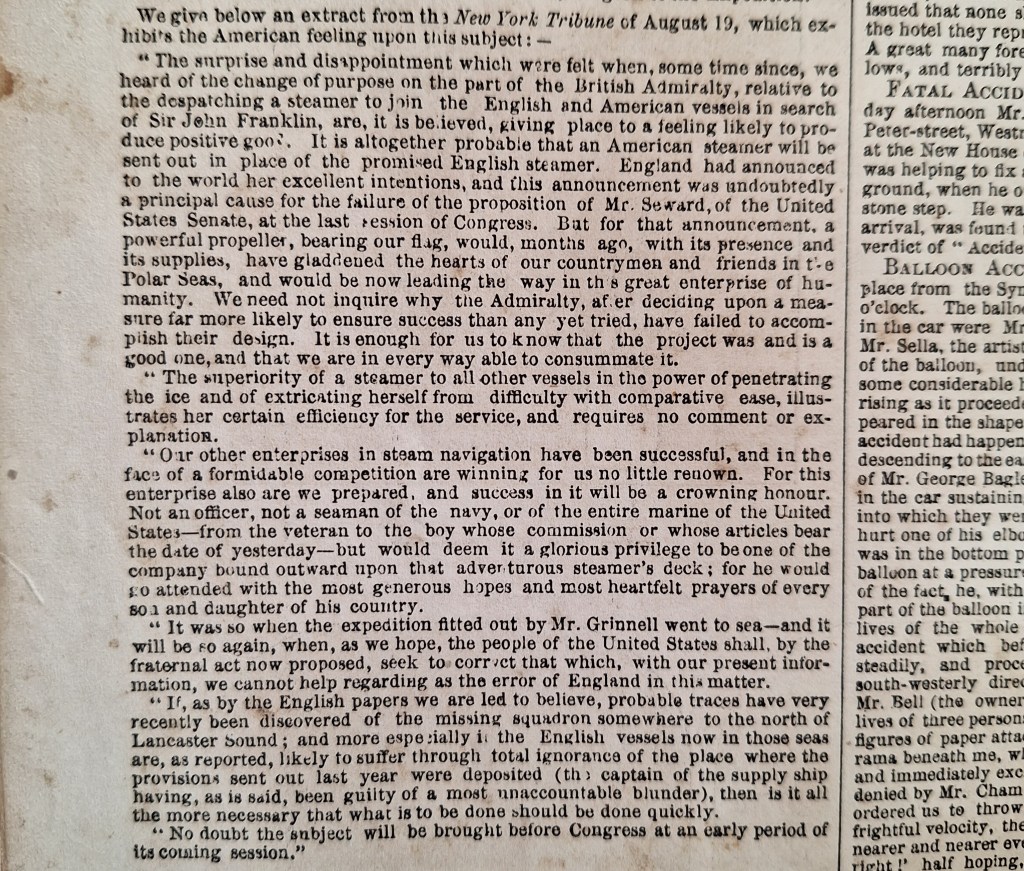
The Illustrated London News 13 September 1851 page 330

The Illustrated London News presumably shows us all of the officers that had their picture taken. Because Lady Franklin was the one who commisioned the portraits, she probably only wanted portraits of the officers in her husband’s ship Erebus, which was also the flagship of the Expedition. Captain Crozier of Terror was included as the second in command of the Expedition, besides being a good acquaintance of the Franklins. That the other officers of Terror were not photographed, is clear in a letter Harry Goodsir wrote to his sister Jane, where he mistakenly calls the Daguerreotype artist a Talbotypist:
Lady Franklin has sent down a Talbotypist
– Harry D.S. Goodsir to Jane Ross Goodsir [sister] on 19 May 1845
to take the portraits of all of the
Officers of the Erebus.
[Source: Russell Potter et al., May We Be Spared To Meet On Earth, 2022, p. 125]
Underneath the portraits are the names of the sitters. For those officers who were promoted in absentia after the Expedition had left England their new rank is given, with their rank when they sailed out in parentheses. Unfortunately this was not done correctly for everybody: Graham Gore is called Lieutenant with his new rank Commander in parentheses. James Fitzjames who was promoted to the rank of Captain on 31 December 1845 still gets ranked as Commander with
“Captain [of] Erebus” in parentheses. Fitzjames had been the Captain of Erebus all along, but after his promotion (of which he of course never received word) he was also Captain in rank. Thankfully the article accompanying the portraits does refer to him as Captain James Fitzjames.
These portraits allowed the public for the first time to put faces to the names of the missing officers, a reminder that these were their fellow countrymen who were in need of aid. Looking at the daguerreotypes that the wood engravings were based on, it is clear that the latter are not…. entirely realistic. The only person who has received an upgrade I daresay, is Sir John Franklin who had been recovering from the flu and thus looked quite poorly in his daguerreotype. Harry Goodsir had his underbite fixed, and James Fitzjames got more curls but less handsomeness.
Gleason’s Pictorial 22 November 1851
A few months later on 18 October 1851 the Boston, USA based Gleason’s Pictorial Drawing-Room Companion also published engravings of the Franklin Expedition portraits, and the Americans did deem the lost explorers worthy of the frontpage. In the 11 October 1851 issue of GPDRC the portraits were announced for the next issue thus: “A portrait will be given of Sir John Franklin and nine or ten of his pincipal officers, being faithful likenesses of these intrepid navigators, so long lost to their friends.” On 4 April 1849 Lady Franklin had written to United States President Zachary Taylor requesting his country’s aid in searching for her husband and his men:
Sir,
– Lady Franklin to President Zachary Taylor on 4 April 1849
I address myself to you as the head of a great nation, whose power
to help me I cannot doubt, and in whose disposition to do so, I
have a confidence which I trust you will not deem presumptuous[.]
The name of my husband, Sir John Franklin, is probably not
unknown to you. It is intimately connected with the northern part
of that continent of which the American Republic forms so vast and
conspicuous a portion. When I visited the United States, 3 years
ago, amongst the many proofs I received of respect and courtesy,
there was none which touched and even surprised me more than
the appreciation every where expressed to me of his former services
in geographical discovery, and the interest felt in the enterprize in
which he was then known to be engaged. […]
[Source: Franklin, Lady Jane, and Elce, Erika Behrisch. As Affecting the Fate of My Absent Husband: Selected Letters of Lady Franklin Concerning the Search for the Lost Franklin Expedition, 1848-1860, 2009, p. 68]
The US Government was slow in sending out vessels, and in the Spring of 1850 an expedition financed by American businessman Henry Grinnell had set out to join the British search expedition. The Grinnell Expedition arrived back in New York on 30 September 1851. As we can read in the ILN article, the US expedition had helped with finding traces of the Franklin Expedition on Beechey Island. The American involvement in the search for Franklin made the Franklin Expedition portraits relevant to the American reader.
Interestingly my copy of Gleason’s is of 22 November 1851, while the digitally available Gleason’s all show the 18 October issue to be the one featuring the Franklin Expedition portraits. The two front-pages show a selection of the portraits (leaving out Reid, Sargent, Collins, Goodsir, and Couch) and the 22 November one inexplicably swaps the places of Le Vesconte and Crozier.


Source: Google Books

The Daguerreotypes side by side
Use the slider to see the images in reverse, which is the original orientation of the sitter (if the daguerreotype is the original and not a ‘copy’, and no mirror/prism has been used when taking the picture). Slide all the way to the right for the original daguerreotypes, and to the left for the reversed version.
Henry Foster Collins (Second Master)

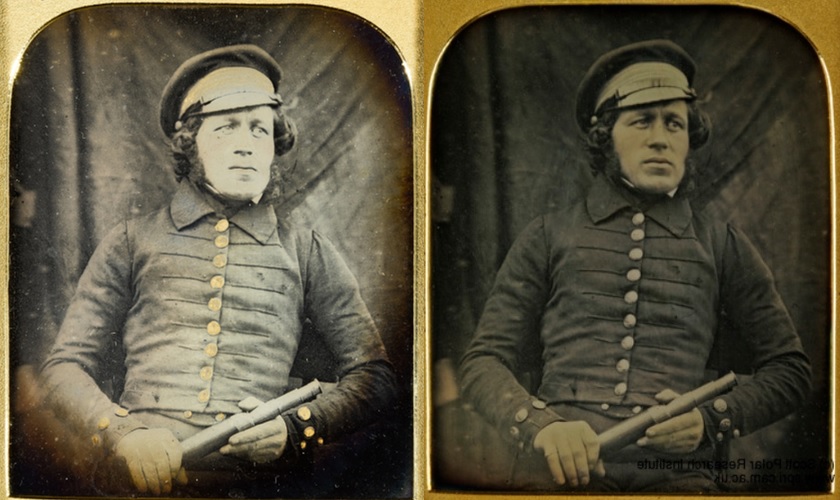
Edward Couch (Mate, later Lieutenant)


Charles Frederick Des Voeux (Mate, later Lieutenant)


James Fitzjames (Commander, later Captain)


Harry Duncan Spens Goodsir (Assistant Surgeon)
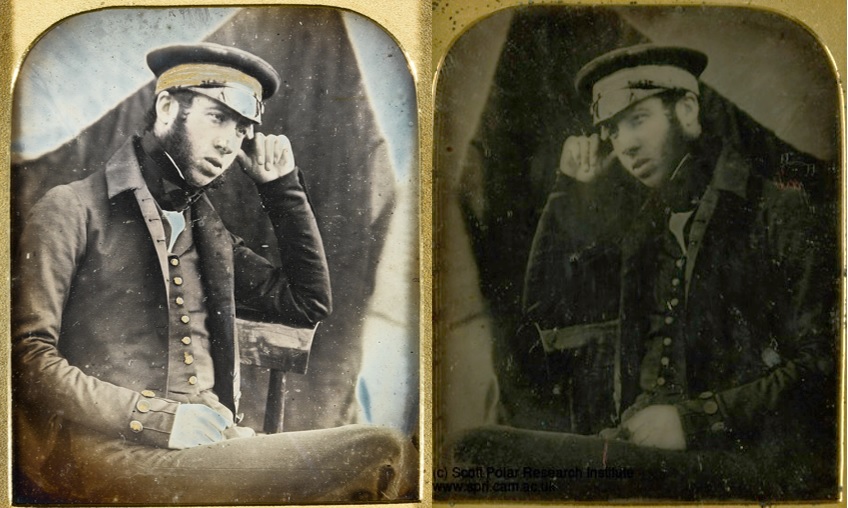

Graham Gore (Lieutenant, later Commander)


Henry Thomas Dundas Le Vesconte (Lieutenant)


James Walter Fairholme (Lieutenant)

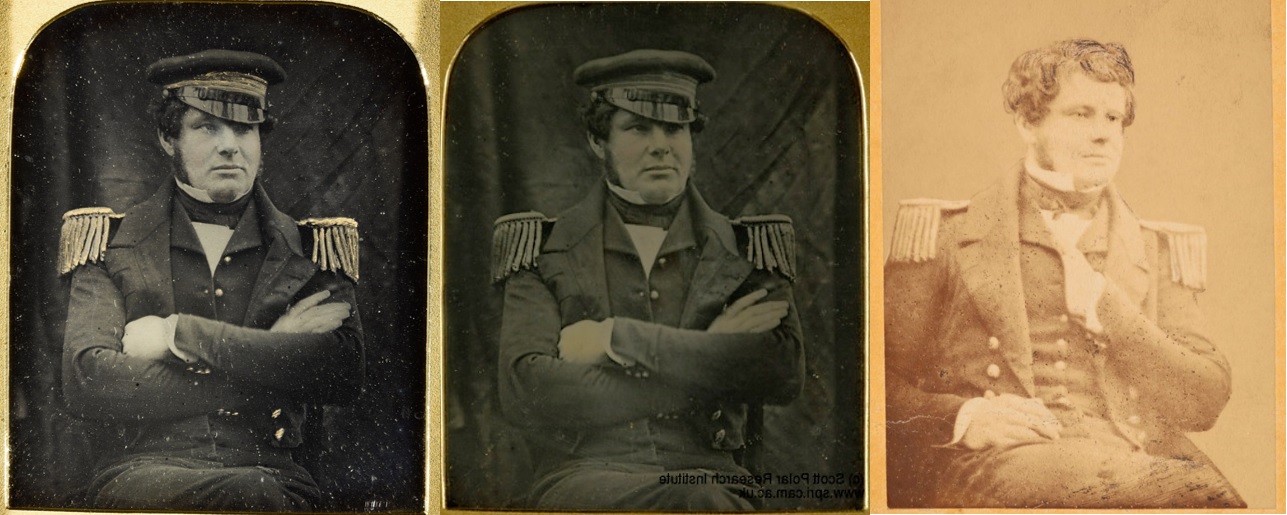
Sir John Franklin (Captain, later Rear-Admiral)

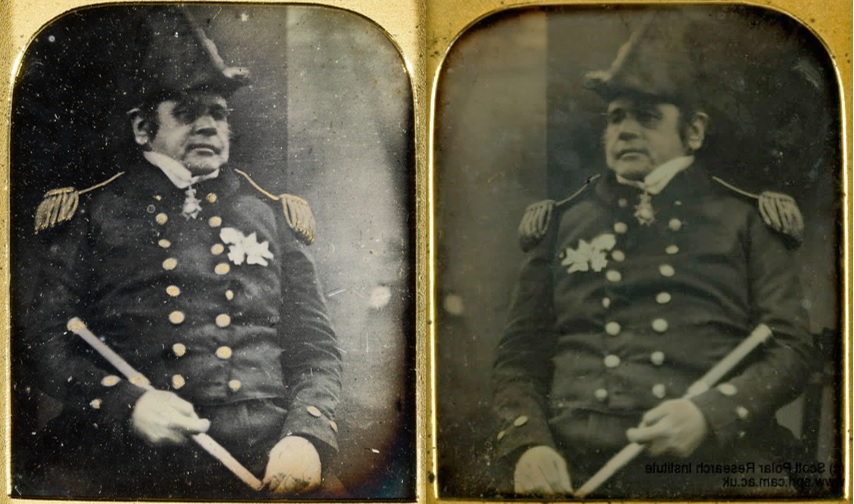
Charles Hamilton Osmer (Purser)


James Reid (Ice Master)
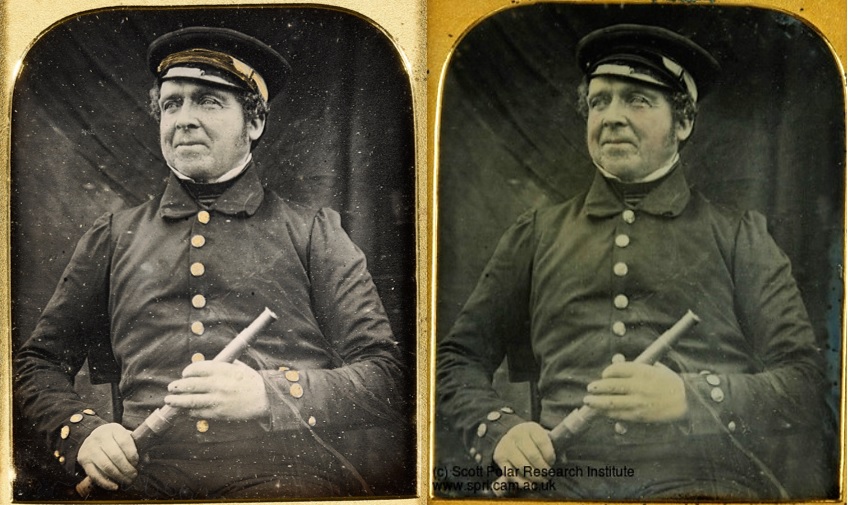
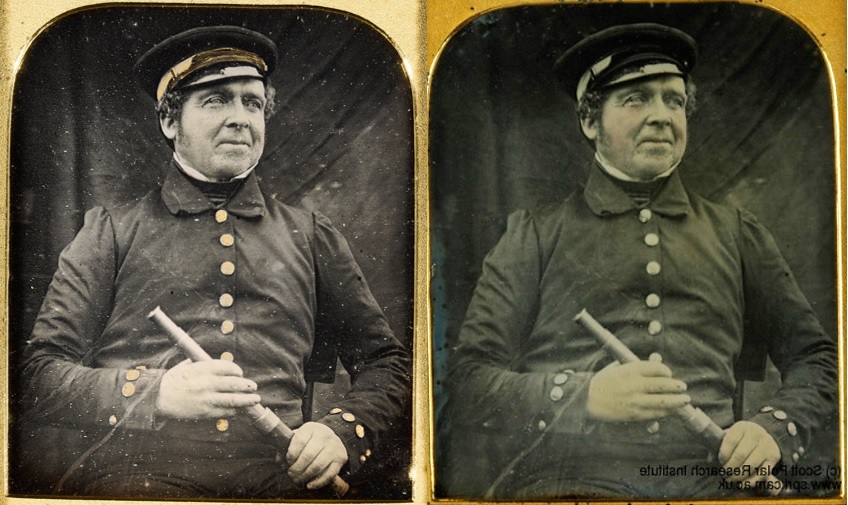
Stephen Stanley (Surgeon)

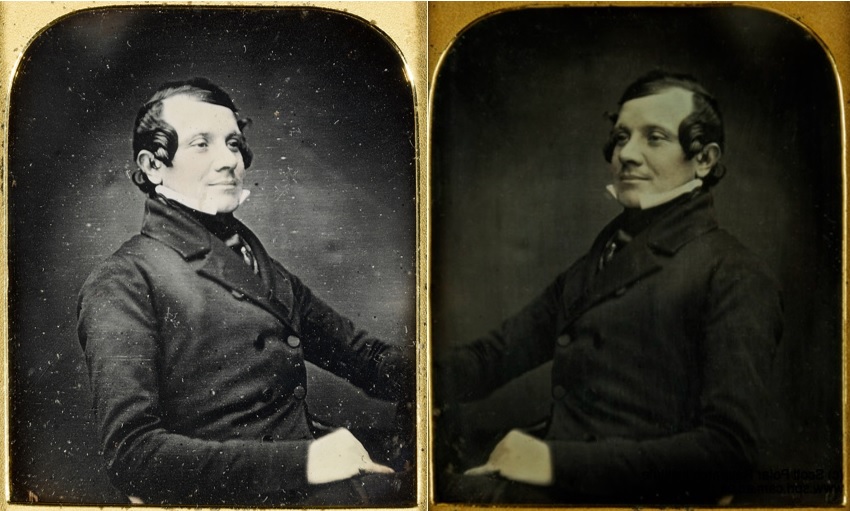
Francis Rawdon Moira Crozier (Captain)
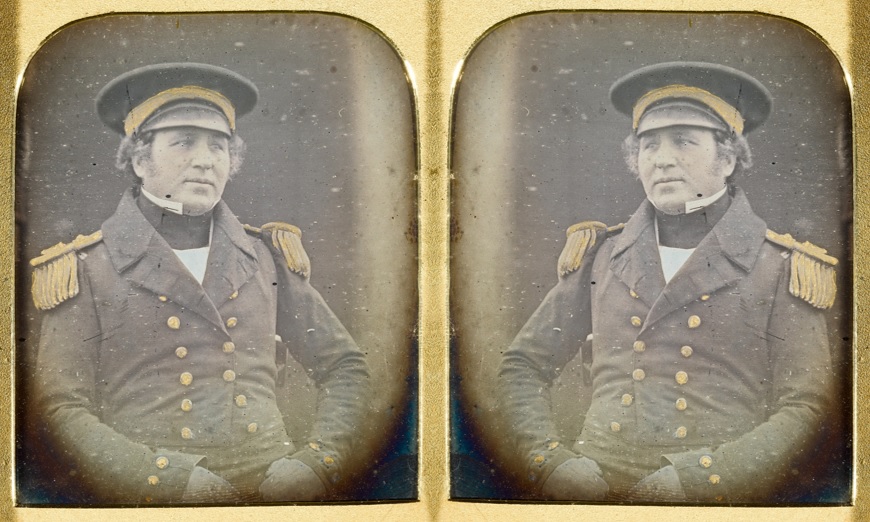
Robert Orme Sargent (Mate, later Lieutenant)
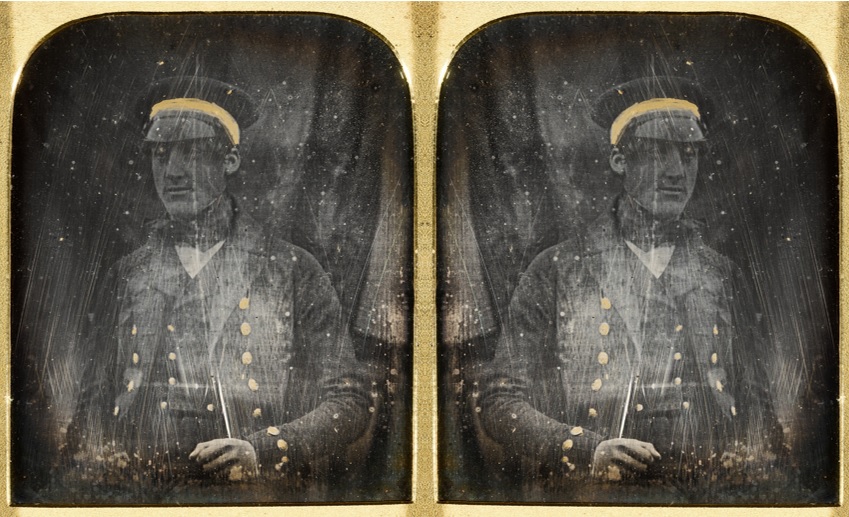
“The White North has their bones”
Mounted Sets
Derbyshire Record Office

The Gell family gradually donated their family archive to the Derbyshire Record Office (DRR) in the 20th century. This mounted set also came from the Gell family. In their online catalogue the DRR says: “The daguerreotypes were subsequently themselves photographed and three sets of prints created; the other sets are at the National Maritime Museum in Greenwich and the Scott Polar Research Institute.” While the NMM has two mounted sets (one of them is pictured below), SPRI has daguerreotypes and no prints. In their exhibition space SPRI does show printed reproductions of the daguerreotypes, while the actual daguerreotypes are kept in their archive and can be viewed by appointment only.
National Maritime Museum, Greenwich
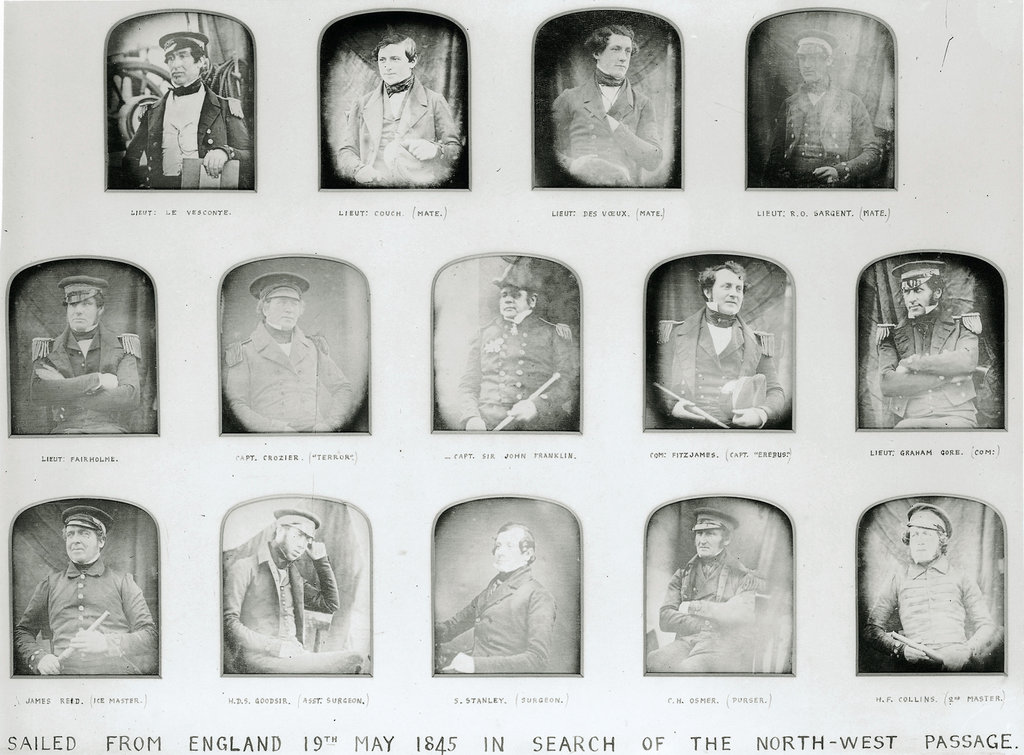
The NMM does not know the provenance of the two mounted sets they own, but they are certain that they must have been produced in the 19th century. (Thank you to curator Jeremy Michell for this information)
Further reading
https://www.thethousandthpart.com/notes/the-big-picture – Detailed overview/analysis of the known Franklin Expedition daguerreotypes and their contemporary copies by Olga Kimmins


